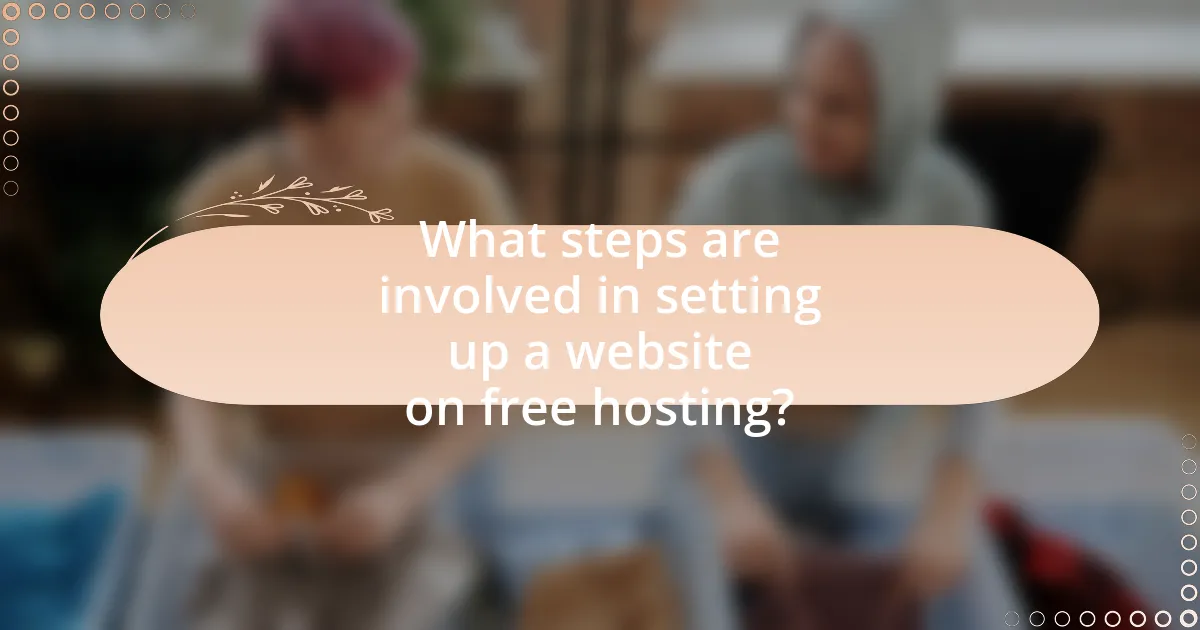Free hosting for websites is a cost-effective service that allows users to create and manage websites without financial investment, making it particularly appealing for beginners. This article provides a comprehensive guide on setting up a website using free hosting, detailing the differences between free and paid hosting, common limitations, and essential features offered by free hosting providers. It also outlines the steps for selecting a suitable provider, creating a website, and optimizing performance while addressing potential challenges beginners may face. Key recommendations for maximizing the experience with free hosting are included, ensuring users can effectively navigate their web development journey.

What is Free Hosting for Websites?
Free hosting for websites is a service that allows individuals or organizations to host their websites on the internet without incurring any costs. This type of hosting typically provides limited resources, such as storage space and bandwidth, and may include advertisements on the hosted site. According to a report by HostingAdvice, many free hosting providers offer basic features suitable for personal projects or small websites, but they often lack the reliability and support found in paid hosting services.
How does free hosting differ from paid hosting?
Free hosting differs from paid hosting primarily in terms of features, reliability, and support. Free hosting typically offers limited storage, bandwidth, and functionality, often displaying ads on user websites, while paid hosting provides more resources, enhanced performance, and customer support. For instance, a study by HostingAdvice in 2021 indicated that paid hosting services generally have 99.9% uptime guarantees, compared to free hosting, which can experience frequent downtimes and slower speeds due to shared resources. Additionally, paid hosting often includes domain registration and advanced security features, which are usually absent in free hosting options.
What are the limitations of free hosting services?
Free hosting services have several limitations, including restricted storage space, limited bandwidth, and lack of customer support. These services often impose caps on the amount of data you can store and transfer, which can hinder website performance and accessibility. Additionally, free hosting typically includes advertisements on your site, reducing professionalism and user experience. Security features are often minimal, leaving websites vulnerable to attacks. Furthermore, users may face restrictions on custom domain names, forcing them to use subdomains that can affect branding and credibility.
What features are commonly offered by free hosting providers?
Free hosting providers commonly offer features such as limited storage space, bandwidth, and subdomain usage. These providers typically allow users to create websites without upfront costs, making them accessible for beginners. For instance, many free hosting services provide a basic website builder, email support, and the ability to run simple applications. Additionally, users often encounter advertisements on their sites, which is a trade-off for the free service. According to a survey by HostingAdvice, 70% of free hosting users reported that limited resources were a common drawback, highlighting the constraints associated with these services.
Why should beginners consider free hosting?
Beginners should consider free hosting because it allows them to create and manage a website without incurring any costs, making it an accessible option for those new to web development. Free hosting platforms often provide user-friendly interfaces and essential features, enabling beginners to learn the basics of website creation and management without financial risk. According to a survey by HostingAdvice, 70% of new website owners start with free hosting to test their ideas before investing in paid services, highlighting its role as a practical stepping stone in the web development journey.
What are the advantages of using free hosting for first-time website creators?
Free hosting offers several advantages for first-time website creators, primarily including cost-effectiveness, ease of use, and accessibility. First, the absence of financial investment allows beginners to experiment with website creation without the risk of losing money, which is crucial for those who are uncertain about their commitment to maintaining a website. Additionally, many free hosting platforms provide user-friendly interfaces and templates, simplifying the process of building a website for individuals with limited technical skills. Furthermore, free hosting services often include built-in tools for website management and analytics, enabling users to track their site’s performance easily. These features collectively empower first-time creators to learn and grow their online presence without significant barriers.
How can free hosting help in learning web development?
Free hosting can significantly aid in learning web development by providing a cost-effective platform for beginners to practice and experiment with their skills. It allows learners to deploy websites without financial barriers, facilitating hands-on experience with essential technologies such as HTML, CSS, and JavaScript. According to a survey by Stack Overflow, 70% of developers reported that practical experience is crucial for skill development, highlighting the importance of accessible resources like free hosting. This environment encourages experimentation, debugging, and understanding server-client interactions, which are vital components of web development.

What steps are involved in setting up a website on free hosting?
To set up a website on free hosting, follow these steps: First, choose a free hosting provider, such as WordPress.com, Wix, or Weebly, which offer user-friendly interfaces and templates. Next, create an account with the selected provider by providing necessary information like email and password. After account creation, select a domain name, which may be a subdomain provided by the host, such as yoursite.wordpress.com. Then, customize your website using the available templates and tools, adding content like text, images, and links. Finally, publish your website, making it accessible to the public. These steps are validated by the widespread use of these platforms, which collectively host millions of websites globally.
How do you choose the right free hosting provider?
To choose the right free hosting provider, evaluate the provider’s reliability, features, and limitations. Reliability is crucial; select a provider with a proven uptime record, ideally above 99.9%, to ensure your website remains accessible. Features such as storage space, bandwidth, and support for programming languages should align with your website’s needs. Additionally, consider limitations like ads on your site, restricted resources, or lack of customer support, which can impact your user experience. Research user reviews and comparisons to validate your choice, as platforms like HostingAdvice and CNET provide insights into various free hosting options.
What factors should you consider when selecting a free hosting service?
When selecting a free hosting service, consider factors such as storage capacity, bandwidth limits, uptime reliability, customer support, and the presence of ads. Storage capacity and bandwidth limits determine how much data you can store and transfer, which is crucial for website performance. Uptime reliability is essential, as a service with high uptime ensures your website remains accessible; for instance, a service with 99.9% uptime guarantees minimal downtime. Customer support is important for resolving issues quickly, and services that offer 24/7 support are preferable. Lastly, the presence of ads can affect user experience; some free hosting services display ads on your site, which may not align with your branding goals.
Which popular free hosting providers are recommended for beginners?
Popular free hosting providers recommended for beginners include WordPress.com, Wix, and Weebly. WordPress.com offers a user-friendly interface and a wide range of themes, making it ideal for those new to website creation. Wix provides a drag-and-drop builder that simplifies the design process, while Weebly combines ease of use with e-commerce capabilities. These platforms are widely recognized for their accessibility and support for novice users, making them suitable choices for individuals starting their first website.
What are the essential steps to create your first website?
To create your first website, follow these essential steps: choose a domain name, select a web hosting service, design your website, and publish it.
Choosing a domain name involves selecting a unique and relevant name that reflects your website’s purpose. Selecting a web hosting service is crucial, as it provides the server space for your website; many free hosting options are available, such as WordPress.com or Wix. Designing your website can be done using website builders or content management systems, which offer templates and tools for customization. Finally, publishing your website makes it accessible on the internet, allowing users to visit and interact with your content.
These steps are foundational for anyone looking to establish an online presence, and numerous resources are available to assist beginners in each phase.
How do you register a domain name with free hosting?
To register a domain name with free hosting, first, choose a free hosting provider that offers domain registration services, such as InfinityFree or 000webhost. After selecting a provider, create an account on their platform. During the registration process, you will typically find an option to register a new domain name or link an existing one. Follow the prompts to enter your desired domain name and complete the registration. Many free hosting services provide a subdomain option if you do not want to register a custom domain. This process is valid as numerous free hosting providers facilitate domain registration as part of their services, allowing users to establish an online presence without incurring costs.
What tools are available for building your website on free hosting?
Website builders such as WordPress.com, Wix, and Weebly are available for building your website on free hosting. These platforms provide user-friendly interfaces and templates that simplify the website creation process. For instance, WordPress.com offers a range of customizable themes and plugins, while Wix features a drag-and-drop editor that allows users to design their sites without coding knowledge. Weebly also provides similar functionalities, making it accessible for beginners. Each of these tools supports free hosting options, enabling users to launch their websites without upfront costs.

What common challenges might beginners face with free hosting?
Beginners often face several common challenges with free hosting, including limited storage and bandwidth, lack of customer support, and potential downtime. Limited storage and bandwidth can restrict the growth of a website, as many free hosting services impose strict limits that may not accommodate increased traffic or content. The absence of reliable customer support can leave beginners without assistance when technical issues arise, making it difficult to resolve problems quickly. Additionally, free hosting services may experience frequent downtime, which can negatively impact website accessibility and user experience. These challenges can hinder a beginner’s ability to effectively launch and maintain a website.
How can you troubleshoot issues with free hosting?
To troubleshoot issues with free hosting, first identify the specific problem, such as website downtime, slow loading speeds, or error messages. Next, check the hosting provider’s status page or support forums for any reported outages or maintenance activities. Additionally, clear your browser cache and cookies, as these can sometimes cause display issues. If the problem persists, verify your domain settings and ensure that your DNS records are correctly configured. Finally, reach out to the hosting provider’s customer support for assistance, as they can provide insights specific to their service.
What are the most frequent problems encountered by new users?
New users frequently encounter issues such as difficulty navigating the hosting platform, challenges in domain name registration, and problems with website design and customization. These problems arise due to unfamiliarity with the interface, lack of understanding of domain management, and limited knowledge of web design principles. For instance, a survey by the Web Hosting Industry Association found that 40% of new users struggle with setting up their website due to confusing user interfaces and inadequate tutorials. Additionally, many users face technical issues related to server configurations and performance optimization, which can hinder their ability to launch a functional website.
How can you optimize your website’s performance on free hosting?
To optimize your website’s performance on free hosting, focus on minimizing file sizes and optimizing images. Reducing the size of HTML, CSS, and JavaScript files can significantly decrease load times, as studies show that a 1-second delay in page response can result in a 7% reduction in conversions. Additionally, using image formats like WebP can reduce image sizes without sacrificing quality, leading to faster loading times. Implementing browser caching can also enhance performance by storing frequently accessed resources locally, reducing server requests. These strategies collectively improve user experience and site speed, which are critical for retaining visitors.
What best practices should you follow when using free hosting?
When using free hosting, prioritize selecting a reputable provider to ensure reliability and security. Reputable providers often offer better uptime, customer support, and security features, which are crucial for maintaining your website’s performance and protecting user data. Additionally, regularly back up your website content to prevent data loss, as free hosting services may not provide automatic backups. Implementing basic SEO practices, such as optimizing your website’s title tags and meta descriptions, can enhance visibility in search engines, even on a free platform. Lastly, be aware of the limitations of free hosting, such as bandwidth restrictions and potential ads on your site, and plan accordingly to avoid disruptions.
How can you ensure your website remains secure on free hosting?
To ensure your website remains secure on free hosting, implement strong passwords and enable two-factor authentication. Strong passwords reduce the risk of unauthorized access, while two-factor authentication adds an additional layer of security by requiring a second form of verification. Additionally, regularly update your website’s software and plugins to patch vulnerabilities, as outdated systems are prime targets for attacks. According to a report by the Cybersecurity & Infrastructure Security Agency, 60% of breaches involve unpatched vulnerabilities, highlighting the importance of keeping software current. Lastly, utilize HTTPS to encrypt data transmitted between the user and the server, which protects sensitive information from interception.
What strategies can help you effectively manage your website on free hosting?
To effectively manage your website on free hosting, prioritize regular backups and content updates. Regular backups ensure that your data is safe in case of service interruptions or data loss, while frequent content updates keep your site relevant and engaging for visitors. According to a study by HubSpot, websites that are updated regularly can see a 55% increase in traffic. Additionally, utilize analytics tools to monitor performance and user engagement, allowing you to make informed decisions about content and design adjustments. This data-driven approach enhances user experience and can lead to higher retention rates.
What are some tips for maximizing your experience with free hosting?
To maximize your experience with free hosting, choose a reliable provider that offers sufficient bandwidth and storage. Reliable providers often have positive user reviews and a track record of uptime, which is crucial for maintaining website accessibility. Additionally, utilize the available resources such as tutorials and community forums provided by the hosting service to enhance your understanding and troubleshoot issues effectively. Engaging with these resources can lead to better website management and optimization. Lastly, regularly back up your website data, as free hosting services may not guarantee data recovery, ensuring that your content remains safe and retrievable.